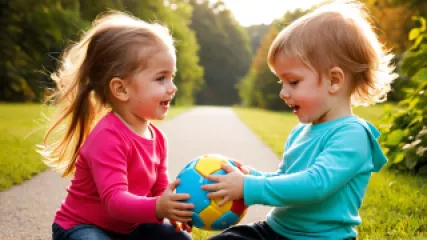Positive Sibling Interactions: Navigating and Resolving Sibling Rivalry
Positive Sibling Interactions: Navigating and Resolving Sibling Rivalry
Sibling relationships can be among the most complex and challenging of all human connections. While the bonds between siblings can be incredibly strong and rewarding, they are also often marked by intense rivalry, competition, and conflict. Managing sibling rivalry is a common concern for parents and caregivers, as they navigate the delicate balance of fostering healthy relationships between their children.
In this research summary, we will explore the underlying causes of sibling rivalry, as well as effective strategies for promoting positive sibling interactions and resolving conflicts. By delving into the psychological, social, and developmental factors that shape sibling dynamics, we aim to provide a comprehensive understanding of this ubiquitous phenomenon and offer practical guidance for parents, caregivers, and siblings themselves.
Understanding the Roots of Sibling Rivalry
Sibling rivalry is a natural and universal aspect of family life, rooted in the inherent competition for parental attention, resources, and affection. From an evolutionary perspective, sibling rivalry can be seen as a means of ensuring individual survival and maximizing one's chances of passing on genetic material to the next generation. This competitive drive is often amplified by the limited resources and parental time available within a household, leading to conflicts over material goods, privileges, and parental favoritism.
Additionally, sibling relationships are shaped by a complex interplay of psychological, social, and developmental factors. Personality differences, birth order, age gaps, and gender dynamics can all contribute to the intensity and nature of sibling rivalries. Older siblings may feel threatened by the arrival of a younger sibling, while younger siblings may struggle with feelings of inferiority or resentment towards their older counterparts. Sibling rivalry can also be exacerbated by parenting styles, family dynamics, and the broader social and cultural contexts in which the family is embedded.
It is important to note that the presence of sibling rivalry does not necessarily indicate a dysfunctional family or a lack of love between siblings. In fact, some degree of sibling rivalry is considered a normal and even healthy aspect of child development, as it helps siblings learn important social skills, such as conflict resolution, negotiation, and empathy.
Strategies for Promoting Positive Sibling Interactions
While sibling rivalry is a natural part of family life, there are numerous strategies that parents and caregivers can employ to foster positive sibling interactions and minimize the negative impacts of rivalry.
Establishing Clear Boundaries and Expectations
One key step in promoting positive sibling interactions is to establish clear boundaries and expectations within the family. This involves setting ground rules for acceptable behavior, resolving conflicts in a constructive manner, and ensuring that each child feels valued and heard. By creating a structured and predictable environment, parents can help siblings develop a stronger sense of security and trust, which can ultimately reduce the intensity of rivalries.
Fostering Individuality and Celebrating Differences
Rather than encouraging competition between siblings, parents and caregivers can focus on highlighting the unique strengths and talents of each child. This involves actively celebrating the individual interests, skills, and accomplishments of each sibling, rather than making comparisons or pitting them against one another. By fostering a sense of individuality and appreciation for differences, parents can help siblings develop a stronger sense of self-worth and reduce the need to compete for parental attention and approval.
Encouraging Collaboration and Cooperation
In addition to celebrating individuality, parents can also promote positive sibling interactions by encouraging collaboration and cooperation between their children. This may involve assigning joint tasks or responsibilities, facilitating shared hobbies or activities, and teaching conflict resolution skills. By working together towards common goals, siblings can learn to appreciate each other's strengths, develop empathy, and strengthen their bond.
Providing One-on-One Time
Another effective strategy for reducing sibling rivalry is to ensure that each child receives dedicated, one-on-one attention from their parents or caregivers. This individualized time can help meet a child's need for attention and validation, reducing the likelihood that they will feel the need to compete for parental affection. Parents can schedule regular, uninterrupted playtime or special outings with each of their children, fostering a stronger sense of individual connection and security.
Modeling Positive Conflict Resolution
Finally, parents and caregivers can play a crucial role in teaching their children how to resolve conflicts in a healthy and constructive manner. By modeling effective communication, active listening, and compromise, adults can help siblings develop the skills necessary to navigate their own disputes. This not only reduces the intensity of sibling rivalries but also equips children with valuable life skills that they can carry forward into their own relationships.
Navigating Specific Sibling Rivalry Scenarios
While the strategies outlined above can be broadly applied to promote positive sibling interactions, it is important to recognize that sibling rivalry can manifest in a variety of ways, each requiring a tailored approach. Let's explore some common sibling rivalry scenarios and discuss effective interventions:
Rivalry over Parental Attention and Affection
One of the most common sources of sibling rivalry is the competition for parental attention and affection. To address this, parents can make a conscious effort to provide each child with individualized quality time, as well as to ensure that they are distributing their attention and praise equitably among their children. This may involve scheduling regular one-on-one outings or activities, as well as being mindful of the language they use when addressing their children.
Conflicts over Resources and Possessions
Disputes over material goods, personal space, and shared possessions can also be a significant source of sibling rivalry. To mitigate these conflicts, parents can establish clear rules and routines around the use and sharing of resources, as well as provide opportunities for siblings to negotiate and compromise. Additionally, parents can encourage their children to develop a sense of ownership and responsibility over their own belongings, reducing the need to compete for shared resources.
Resentment and Jealousy over Perceived Favoritism
Sibling rivalry can also arise from a perceived sense of parental favoritism or unfair treatment. To address this, parents must be vigilant in ensuring that they are providing equal attention, support, and opportunities to all of their children, regardless of individual differences or circumstances. This may involve regularly checking in with each child to understand their unique needs and concerns, and making conscious efforts to celebrate the accomplishments and strengths of all siblings.
Conflicts Stemming from Personality Differences and Birth Order
Personality differences and birth order can also contribute to the dynamics of sibling rivalry. Older siblings may feel threatened by the arrival of a younger sibling, while younger siblings may struggle with feelings of inferiority or resentment. Parents can help mitigate these challenges by fostering a sense of cooperation and collaboration, as well as by acknowledging and validating the unique needs and perspectives of each child.
The Long-Term Benefits of Positive Sibling Relationships
While sibling rivalry can be a source of stress and conflict within families, research has shown that the development of positive sibling relationships can have far-reaching and long-lasting benefits for individuals and families alike. Siblings who are able to navigate their rivalries and develop strong, supportive bonds often exhibit higher levels of emotional intelligence, empathy, and social competence, which can contribute to their overall well-being and success in life.
Furthermore, positive sibling relationships can serve as a valuable source of social support, particularly during times of stress or adversity. Siblings who have developed a strong sense of trust, loyalty, and understanding can provide each other with a safe haven, a sounding board, and a source of unconditional love and acceptance – all of which can have a profound impact on their mental health and overall quality of life.
By prioritizing the development of positive sibling interactions, parents and caregivers can not only mitigate the negative impacts of sibling rivalry but also lay the foundation for lifelong, fulfilling relationships between their children. This investment in sibling bonding can have a ripple effect, strengthening the entire family unit and paving the way for more harmonious, supportive, and resilient family dynamics.
Conclusion
Sibling rivalry is a complex and multi-faceted phenomenon that is deeply rooted in the psychological, social, and developmental factors that shape family dynamics. While the presence of sibling rivalries is a natural and often unavoidable aspect of family life, there are numerous strategies that parents and caregivers can employ to promote positive sibling interactions and resolve conflicts in a constructive manner.
By establishing clear boundaries and expectations, fostering individuality and celebrating differences, encouraging collaboration and cooperation, providing one-on-one time, and modeling positive conflict resolution, parents can help their children develop the skills and mindsets necessary to navigate the ups and downs of sibling relationships. This investment in positive sibling interactions not only mitigates the negative impacts of rivalry but also lays the foundation for lifelong, fulfilling relationships between siblings – relationships that can serve as a source of support, love, and resilience for years to come.
As we continue to explore the complexities of sibling relationships and the strategies for promoting positive interactions, it is our hope that families and caregivers will be empowered to navigate the challenges of sibling rivalry with greater understanding, compassion, and skill. By prioritizing the development of healthy, supportive sibling bonds, we can contribute to the overall well-being and flourishing of individuals, families, and communities alike.






